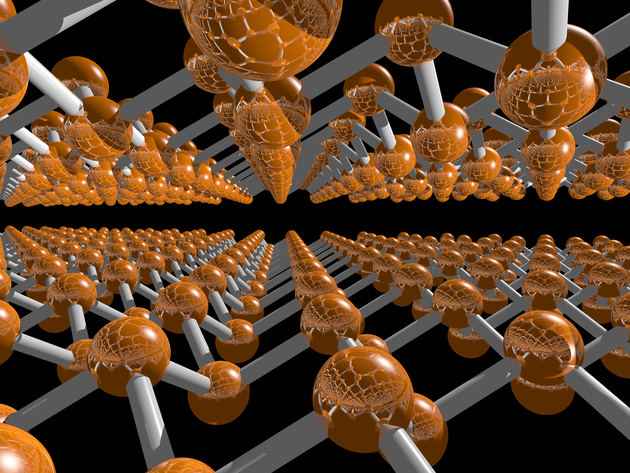Nov 6 2020
Blue phosphorus is an atomically thin synthetic semiconductor that turns metallic once it is transformed into a double layer.
 The international team modeled a two-layer buckled honeycomb structure of blue phosphorus by means of highly precise calculations on high-performance computers. The compound is very stable and due to the very small distance between the two layers, it has metallic properties. Image Credit: Jessica Arcudia.
The international team modeled a two-layer buckled honeycomb structure of blue phosphorus by means of highly precise calculations on high-performance computers. The compound is very stable and due to the very small distance between the two layers, it has metallic properties. Image Credit: Jessica Arcudia.
This discovery was made by an interdisciplinary research team under the guidance of Professor Thomas Heine from TU Dresden and Prof Gabriel Merino from the Mexican research institute Cinvestav Merida.
The researchers are the first ones to propose the potential of developing nanoscale, highly efficient transistors comprising of only one element.
The findings of these investigations were published as a highlight article in the latest issue of the Physical Review Letters journal.
Phosphorus is a chemical element regarded to be one of the most important elements for life. Phosphorus compounds are strongly involved in the structure and function of organisms. Each human carries around 1 kg of phosphorus in the body. However, even outside the bodies, one is surrounded by phosphates as well as phosphonates in their day-to-day lives: in the food, in fertilizers, detergents, or medicines.
Phosphorus exists in many different forms with extremely different properties. Under regular conditions, a difference can be found between black, red, purple, and white phosphorus. In 2014, a group of researchers from Michigan State University computationally predicted “blue phosphorus,” which could be experimentally synthesized two years later.
Blue phosphorus is a purported two-dimensional (2D) material. Its single-layer honeycomb-like structure makes it similar to the better known 2D material—graphene.
Similar to its well-known forerunner, it was later also known as blue phosphorene. Since then, this new semiconductor material has been explored as a high potential candidate for optoelectronic devices.
In collaboration with Mexican researchers, Prof. Thomas Heine, a chemist at TU Dresden, has currently made a special discovery: they used a topological concept to computationally find an extremely stable two-layer buckled honeycomb structure of blue phosphorene through highly accurate calculations on high-performance computers.
This two-layered compound tends to be highly stable. The researchers unexpectedly identified that it exhibits metallic properties because of the very small distance between the two layers.
Similar to all components, these devices must be provided with power, which generally enters the material through metal electrodes. Loss in energy at the metal-semiconductor interface is unavoidable—an effect called the Schottky barrier.
As a single layer, blue phosphorus acts as a semiconductor; however, as a double layer, it is expected to be metallic. Metallic 2D materials are extremely rare, and this is the first time a pure elemental material with a semiconductor-metal transition from the monolayer to the double layer has been found.
Hence, it is possible to achieve an optoelectronic or electronic component for use in photocells or transistors from only one chemical element. As there is no interface present between metal and semiconductor in such devices, the Schottky barrier is considerably decreased and higher efficiency can be anticipated.
Imagine you put two layers of paper on top of each other and suddenly the double sheet shines metallically like gold foil. This is exactly what we predict for blue phosphorene. This work underlines the importance of interdisciplinarity in basic research. Using a topological-mathematical model and theoretical chemistry, we were able to design a new material on the computer and predict its physical properties. Applications in the field of nano- and optoelectronics are expected.
Thomas Heine, Professor, TU Dresden
To achieve these potential outcomes in fundamental research, first author Jessica Arcudia from Mexico has already been awarded the LatinXChem poster prize and the ACS Presidential Award.
The young chemist was a guest student in the research team of Thomas Heine in 2018, where her doctoral supervisor Professor Gabriel Merino had also worked before.
Journal Reference:
Arcudia, J., et al. (2020) Blue Phosphorene Bilayer Is a Two-Dimensional Metal and an Unambiguous Classification Scheme for Buckled Hexagonal Bilayers. Physical Review Letters. doi.org/10.1103/PhysRevLett.125.196401.